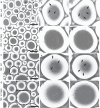Co-cultivation of microbial sub-communities in microfluidic droplets facilitates high-resolution genomic dissection of microbial 'dark matter'
- PMID: 33089329
- PMCID: PMC7671993
- DOI: 10.1093/intbio/zyaa021
Co-cultivation of microbial sub-communities in microfluidic droplets facilitates high-resolution genomic dissection of microbial 'dark matter'
Abstract
While the 'unculturable' majority of the bacterial world is accessible with culture-independent tools, the inability to study these bacteria using culture-dependent approaches has severely limited our understanding of their ecological roles and interactions. To circumvent cultivation barriers, we utilize microfluidic droplets as localized, nanoliter-size bioreactors to co-cultivate subsets of microbial communities. This co-localization can support ecological interactions between a reduced number of encapsulated cells. We demonstrated the utility of this approach in the encapsulation and co-cultivation of droplet sub-communities from a fecal sample collected from a healthy human subject. With the whole genome amplification and metagenomic shotgun sequencing of co-cultivated sub-communities from 22 droplets, we observed that this approach provides accessibility to uncharacterized gut commensals for study. The recovery of metagenome-assembled genomes from one droplet sub-community demonstrated the capability to dissect the sub-communities with high-genomic resolution. In particular, genomic characterization of one novel member of the family Neisseriaceae revealed implications regarding its participation in fatty acid degradation and production of atherogenic intermediates in the human gut. The demonstrated genomic resolution and accessibility to the microbial 'dark matter' with this methodology can be applied to study the interactions of rare or previously uncultivated members of microbial communities.
Keywords: co-cultivation; human gut; metagenomics; microbial communities; microbiome; microdroplet; microfluidics.
© The Author(s) 2020. Published by Oxford University Press. All rights reserved. For permissions, please e-mail: journals.permissions@oup.com.
Figures




Similar articles
-
Strain-level profiling with picodroplet microfluidic cultivation reveals host-specific adaption of honeybee gut symbionts.Microbiome. 2022 Aug 31;10(1):140. doi: 10.1186/s40168-022-01333-9. Microbiome. 2022. PMID: 36045431 Free PMC article.
-
Spatial metagenomic characterization of microbial biogeography in the gut.Nat Biotechnol. 2019 Aug;37(8):877-883. doi: 10.1038/s41587-019-0183-2. Epub 2019 Jul 22. Nat Biotechnol. 2019. PMID: 31332325 Free PMC article.
-
Quantitative Assessment of Shotgun Metagenomics and 16S rDNA Amplicon Sequencing in the Study of Human Gut Microbiome.OMICS. 2018 Apr;22(4):248-254. doi: 10.1089/omi.2018.0013. OMICS. 2018. PMID: 29652573
-
Targeted metagenomics: a high-resolution metagenomics approach for specific gene clusters in complex microbial communities.Environ Microbiol. 2012 Jan;14(1):13-22. doi: 10.1111/j.1462-2920.2011.02438.x. Epub 2011 Mar 1. Environ Microbiol. 2012. PMID: 21366818 Review.
-
Peeling off the layers from microbial dark matter (MDM): recent advances, future challenges, and opportunities.Crit Rev Microbiol. 2025 Feb;51(1):1-21. doi: 10.1080/1040841X.2024.2319669. Epub 2024 Feb 22. Crit Rev Microbiol. 2025. PMID: 38385313 Review.
Cited by
-
Microdroplet-based system for culturing of environmental microorganisms using FNAP-sort.Sci Rep. 2021 May 4;11(1):9506. doi: 10.1038/s41598-021-88974-2. Sci Rep. 2021. PMID: 33947924 Free PMC article.
-
A digital plating platform for robust and versatile microbial detection and analysis.Sci Rep. 2025 Jul 13;15(1):25301. doi: 10.1038/s41598-025-11525-6. Sci Rep. 2025. PMID: 40653544 Free PMC article.
-
[Application of Droplet-Based Microfluidics in Microbial Research].Sichuan Da Xue Xue Bao Yi Xue Ban. 2023 May;54(3):673-678. doi: 10.12182/20230560303. Sichuan Da Xue Xue Bao Yi Xue Ban. 2023. PMID: 37248604 Free PMC article. Review. Chinese.
-
Research progress in isolation and identification of rumen probiotics.Front Cell Infect Microbiol. 2024 May 21;14:1411482. doi: 10.3389/fcimb.2024.1411482. eCollection 2024. Front Cell Infect Microbiol. 2024. PMID: 38836057 Free PMC article. Review.
-
Droplet Microfluidics for Food and Nutrition Applications.Micromachines (Basel). 2021 Jul 23;12(8):863. doi: 10.3390/mi12080863. Micromachines (Basel). 2021. PMID: 34442486 Free PMC article. Review.
References
-
- Beja O, Aravind L, Koonin EV et al. Bacterial rhodopsin: Evidence for a new type of phototrophy in the sea. Science 2000;289:1902–6. - PubMed
-
- Vanwonterghem I, Evans PN, Parks DH et al. Methylotrophic methanogenesis discovered in the archaeal phylum Verstraetearchaeota. Nat Microbiol 2016;1:16170. - PubMed
-
- Dick G. Genomic Approaches in Earth and Environmental Sciences, 1st edn. Hoboken, New Jersey: John Wiley & Sons, Inc., 2019.
-
- Wang J, Qin J, Li Y et al. A metagenome-wide association study of gut microbiota in type 2 diabetes. Nature 2012;490:55–60. - PubMed
Publication types
MeSH terms
Substances
Grants and funding
LinkOut - more resources
Full Text Sources

